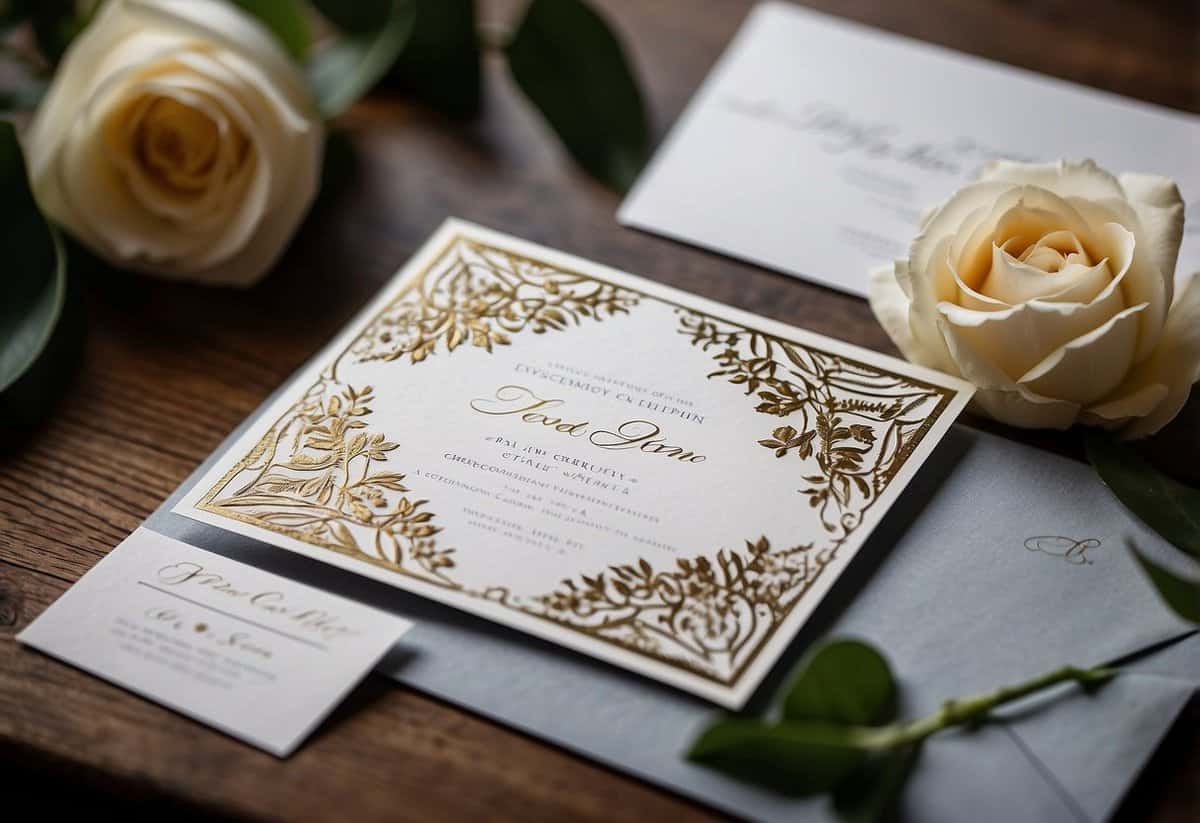What Is the Etiquette for Inviting Guests to a Wedding? Tips for Smooth Planning
Inviting guests to your wedding is one of the most important parts of planning your big day. It’s crucial to follow proper wedding etiquette to ensure everyone feels welcomed and appreciated. Only invite the guests listed on your wedding invitation. This means if the invitation is addressed to just one person, they should not assume they can bring a plus-one.

When creating your guest list, consider splitting it into three parts: one-third for the bride’s family, one-third for the groom’s family, and one-third for friends of the couple. This traditional method can help keep things balanced and fair. Your guest list should ideally be a mix of both families and close friends to make the day special for everyone.
Sending out your wedding invitations well in advance is also key. Invitations should include essential details like the date, time, and location of the wedding. Make sure to send them early enough to give your guests time to plan and RSVP. This step helps ensure that you have an accurate headcount and can make necessary arrangements.
Crafting Your Wedding Invitations

When crafting your wedding invitations, pay attention to wording, style, etiquette, and including RSVP cards. This helps ensure your invitations are clear, stylish, and respectful.
Deciding on the Wording and Style
The wording of your wedding invitation sets the tone for the event. For a formal wedding, use traditional language like “request the honor of your presence.” For informal weddings, a more relaxed tone is appropriate, such as “invite you to celebrate with us.”
Include key details: names of the couple, wedding date, time, and location. Mention who is hosting, if anyone other than the couple is involved, such as parents. Keep the style consistent with your wedding theme, whether it’s rustic, modern, or vintage.
Understanding Proper Etiquette for Invitations
Etiquette is crucial for wedding invitations. Send invitations 8 to 12 weeks before the wedding to allow guests enough time to plan. Address each guest properly; use full names and omit nicknames. Include a return address on the envelopes to ensure you receive responses.
If you have special instructions, such as dress code or no children allowed, include these details politely. Ensure the invitations are clear to avoid misunderstandings among your guests.
Incorporating RSVP and Response Cards
RSVP cards help you manage your guest list. Include these cards with your invitations, asking guests to respond by a specific date. The RSVP card should have a simple format with options to accept or decline, space for guests to write their names, and meal choices if applicable.
Include a stamped return envelope addressed to you. This makes it easy for guests to send their responses. Clear and organized RSVP cards help in planning your seating and catering arrangements smoothly.
For detailed guidance on crafting your invitations, visit resources like The Knot or Brides.
Managing the Guest List

When planning your wedding, deciding who to invite can be a tricky process. You will need to carefully consider family, friends, plus-ones, and children to create a guest list that suits your special day.
Determining Who to Invite
Start by listing everyone you want to invite to your wedding. Prioritize family members and close friends who have been significant in your life. It’s crucial to communicate with both sets of parents to ensure no one important is missed.
Be sure to establish boundaries. Inviting people out of guilt or obligation can add stress. Stick to those who genuinely matter to you. For more tips, you can check these etiquette rules.
Handling Plus-Ones and Children
Decide early on how you will manage plus-ones. Not all guests will need or expect to bring an additional person. A good approach is to offer plus-ones to those who are in serious relationships or those traveling from far away.
For children, consider your wedding’s atmosphere. If you prefer an adults-only event, indicate this clearly on the invitation. If children are welcome, plan to include kid-friendly elements in the celebration. Learn more about managing plus-ones here.
Navigating Family Member Invitations
Navigating family dynamics can be challenging. Try to balance inviting immediate family first and then extend invitations to extended family. Discuss with your fiancé and parents to ensure all key family members receive invitations.
It’s also important to remember that this day is about you and your partner. Set limits if needed. For some, it might be helpful to use the rule of thirds: a third for the bride’s family, a third for the groom’s family, and a third for the couple’s friends. Check out more detailed advice here.
Addressing Invitations to Friends and Coworkers
Deciding which friends and coworkers to invite can be a sensitive area. Start by listing your closest friends and those you’ve maintained meaningful connections with. For coworkers, you are not obligated to invite everyone. Often, one or two close colleagues are enough.
Consider office culture when deciding whom to invite. If you’re inviting several coworkers, it might be more inclusive to invite your entire team or department. Always be discreet to avoid workplace tension. For more on managing guest lists, visit this helpful page.
Setting the Tone Through Invitation Etiquette

Choosing the right dress code and sharing clear venue and reception details are vital elements of wedding invitation etiquette. These decisions convey the style and formality of your big day to your guests.
Choosing the Right Dress Code
Your wedding invitation can guide guests on what to wear through the dress code. Clearly state whether the event is black-tie, semi-formal, or casual. This helps guests feel comfortable and appropriately dressed.
Specify the dress code in a clear spot, like at the bottom of the invitation or on your wedding website. For example, you can write, “Black-tie Attire” or “Casual Dress”. Providing a brief explanation can also be helpful.
Don’t forget to consider the venue and time of day when setting the dress code. A beach wedding will likely have a different dress code than a formal evening ballroom event. Keep the wording simple and straightforward to avoid any confusion.
Communicating Venue and Reception Details
Giving guests the right information about the venue and reception is key. Include the full address of the venue and any specific instructions on how to get there. If the ceremony and reception are at different locations, clearly indicate this and provide directions to both.
Create a wedding website to house all the details. Include a link to it in your invitation. This can provide maps, parking details, and even accommodation options.
Make sure to state the start times for both the ceremony and reception. Indicate if there are any special instructions, like “Arrive 30 minutes early” for a smooth experience. Proper communication ensures your guests have all the details they need for a memorable celebration.
Budget Considerations for Your Invitations

When planning your wedding, it’s essential to plan how you’ll allocate funds for your wedding invitations. Effective budgeting ensures you can invite everyone you want without overspending.
Allocating Funds for Invitation Expenses
Start by deciding how much of your wedding budget will go to invitations. It’s wise to aim for about 2-5% of your total budget.
Next, consider the main expenses: design and printing costs, postage, and extras like custom envelopes or RSVP cards.
Design costs can vary based on if you choose a custom design or a template. Templates are usually less expensive.
Printing costs depend on the type of paper and printing method. Digital printing is generally cheaper than letterpress or engraving.
Don’t forget postage. Mail your invites early to avoid rush fees. Save on postage by choosing standard envelopes over odd shapes or heavy paper.
Extras like envelope liners or custom stamps can add up. If you’re watching your budget, limit these non-essentials.
Setting clear priorities and keeping track of these details helps you stick to your budget without compromising on style or guest experience.
After the Invitations: Next Steps

Once you’ve sent out your wedding invitations, there are several important tasks to tackle. You’ll need to track RSVPs, organize seating arrangements, and provide information on your wedding registry.
Tracking RSVPs and Adjusting Arrangements
Start by creating a system for tracking RSVPs. A spreadsheet can help you list names, responses, and any special dietary needs. This ensures you know exactly who is coming.
Keep an eye on any RSVP deadlines. Send polite reminders to those who haven’t responded. Knowing the final headcount allows you to adjust catering and seating arrangements as needed.
Consider creating an RSVP website where guests can easily confirm their attendance. This can also provide details about the wedding, such as travel arrangements and accommodations. Regularly update your list to stay organized and ensure everything is accounted for.
Organizing Seating and Final Details
Creating a seating chart can be a bit tricky. Start by grouping people who know each other or have common interests. Balance mixing guests with ensuring everyone feels comfortable.
Use sticky notes or digital tools to easily adjust the seating chart. Make room for any last-minute changes due to unexpected RSVPs. Communicate with your venue on table sizes and arrangements to make sure everything fits well.
Keep the wedding party and immediate family in mind first, followed by groups of friends and extended family. If needed, seek support from your wedding planner or a helpful friend to make the seating organization smoother.
Providing Information on Wedding Registry
It’s helpful to give guests a clear idea of what gifts you might like. Include your wedding registry details in your invitation suite or on your wedding website. This gives them plenty of time to choose something special.
Pick a variety of items at different price points to fit everyone’s budget. List practical items you’ll use daily and a few fun, splurge-worthy options. Update your registry regularly to include any new items or remove those already purchased.
Let guests know how they can ship the gifts directly to you if they prefer. This is especially useful for those who might be traveling to your wedding from afar.



